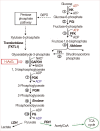Enhanced radiosensitivity and chemosensitivity of breast cancer cells by 2-deoxy-d-glucose in combination therapy
- PMID: 22807930
- PMCID: PMC3395736
- DOI: 10.4048/jbc.2012.15.2.141
Enhanced radiosensitivity and chemosensitivity of breast cancer cells by 2-deoxy-d-glucose in combination therapy
Abstract
Breast cancer is the most common malignancy, and it is also the major cause of cancer-related deaths of women worldwide. Breast cancer treatment involves surgery, chemotherapy, radiation therapy, or combination therapy, and novel strategies are needed to boost the oncologic outcome. The non-metabolizable glucose analogue, 2-deoxy-D-glucose (2-DG) which inhibits glucose synthesis and adenosine triphosphate production, is one of the important discoveries involving the disturbances that can be caused to the process of the metabolism. The glucose analogue, 2-DG, is known as a tumor sensitizer to irradiation (IR) and chemotherapy, which help improve the treatment rates. It enhances the cytotoxicity via oxidative stress, which is more redundant in tumor cells than in normal ones. This article provides a brief summary on studies related to 2-DG chemo-/radio-sensitization effects by combination therapy of 2-DG/IR or 2-DG/doxorubicin.
Keywords: 2-deoxy-D-glucose; Breast neoplasms; Combined modality therapy; Radiation; Tumor cell line.
Conflict of interest statement
The authors declare that they have no competing interests.
Figures



References
-
- Agashe PP, Shrikhande SV. Genetics of breast cancer for the practicing surgeon. [Accessed June 12th, 2011]. http://www.bhj.org/journal/2001_4304_oct/review_537.htm.
-
- Elstner E, Williamson EA, Zang C, Fritz J, Heber D, Fenner M, et al. Novel therapeutic approach: ligands for PPARgamma and retinoid receptors induce apoptosis in bcl-2-positive human breast cancer cells. Breast Cancer Res Treat. 2002;74:155–165. - PubMed
-
- de la Rochefordiere A, Asselain B, Campana F, Scholl SM, Fenton J, Vilcoq JR, et al. Age as prognostic factor in premenopausal breast carcinoma. Lancet. 1993;341:1039–1043. - PubMed
-
- Han W, Kang SY Korean Breast Cancer Society. Relationship between age at diagnosis and outcome of premenopausal breast cancer: age less than 35 years is a reasonable cut-off for defining young age-onset breast cancer. Breast Cancer Res Treat. 2010;119:193–200. - PubMed
LinkOut - more resources
Full Text Sources

